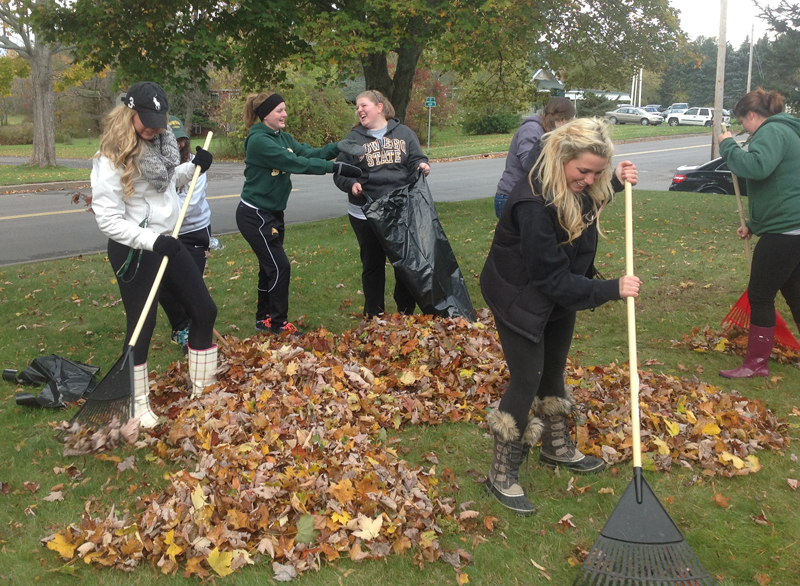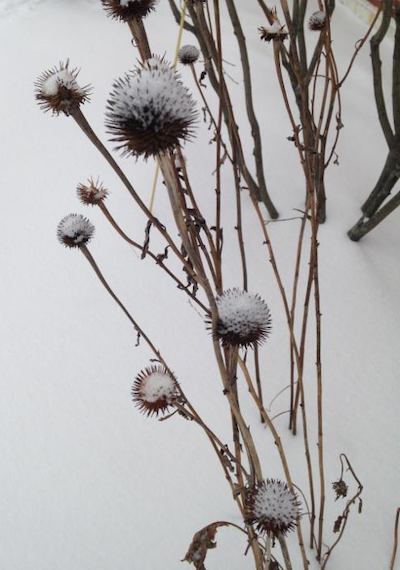Fall Cleanup — Multiple Choices
By George Graine, Fairfax Master Gardener
“A gardener must not feel sorry for himself, even in winter, and no matter how great the cause.” –Henry Mitchell in “The Essential Earthman” (1981)
 You can count on leaf fall every year, and you can also count on perennial plants having their last hurrah at about the same time. Now the question is what should or can be done about this situation? Is fall cleanup a mess or do you recognize that Mother Nature is just doing her annual thing? The dilemma for every gardener is like a multiple choice question because there is so much to consider as well as a combination of choices. Read on for several examples, but first you need to consider several factors that should enter into your decision. For example, will the neighbors think you are slovenly if you do not remove the leaves? Will the soil benefit from the eventual rotting leaves? Will the leaves protect the hidden creatures (insects and more) and is this a good thing?
You can count on leaf fall every year, and you can also count on perennial plants having their last hurrah at about the same time. Now the question is what should or can be done about this situation? Is fall cleanup a mess or do you recognize that Mother Nature is just doing her annual thing? The dilemma for every gardener is like a multiple choice question because there is so much to consider as well as a combination of choices. Read on for several examples, but first you need to consider several factors that should enter into your decision. For example, will the neighbors think you are slovenly if you do not remove the leaves? Will the soil benefit from the eventual rotting leaves? Will the leaves protect the hidden creatures (insects and more) and is this a good thing?
What about those perennials that now look like forlorn sticks (stems)? Some might sneer and give a mighty harrumph at the sight. If this is true, why you can purchase these so-called dried sticks at craft stores and elsewhere in order to make interesting floral arrangements, wreaths and other objects d’art? Also, have you given some thought to the seeds and pods that are attached to the sticks? Indeed, this is another art form as well as a source of food for birds that overwinter in your garden. Think about being a neatnik and simultaneously consider the environment that is surrounding you. For sure this is another choice. In other words, perhaps it is time to stop the madness. The leaf blowers that often fill curbs full of leaves are eventually hauled away. Come spring what happens? Do you trek over to the garden center or the box store to purchase bags of mulch and maybe soil amendments? Repeat — Is it time to stop the madness?
Now let us consider fall cleanup and the horticultural philosophy that stirs this activity. The fact remains that nature is often forgiving about school-driven horticultural rules. If you were to ask “experts” about fall cleanup, most likely you will find several entirely different answers. Surely that will add to the confusion; or is it the mystery or even the dilemma of fall cleanup? Perhaps the correct approach to fall cleanup is to let nature be nature. After all, this is the model for forested areas. The fall cleanup approaches noted below are reasonably well-thought-out, so it is up to the gardener to decide how and even why to deal with the “situation.” Note the carefully chosen word — situation. If this is truly a problem, then what are you going to do about it? Here are a variety of ideas regarding fall cleanup. In the final analysis, the choice is often what is right for you because you should consider several aspects such as time, budget, environment, next spring and even the neighborhood where you live.
- Lately we have been hearing a lot of chatter about pollinators. In that regard, you should allow the leaves to fall in place because they provide an excellent habitat for wildlife such as hidden bees and butterflies. Shredding leaves with a lawn mower is good for the lawn because it adds additional fertilizer. On the other hand, this practice could be harmful to the queen bee and butterfly eggs in the garden. Likewise, cutting down the stems of perennials removes nesting sites for pollinators. Could this be a dilemma for you?
- An opposite approach to fall cleanup is to make a clean sweep of the garden. The point here is to remove any known or unknown infection even if you think your garden has been problem free. This tends to reduce problems next season. The operant word here is “free” because you do not really know what might be lurking below the soil surface. Something might be waiting for the opportune moment to do whatever. Could it be weeds, insects, fungi or the ubiquitous unknown? Since you have made a clean sweep, then the ideal next step is to compost all of the dead and dying plant material. This practice should help reduce the need for pesticide application next year. The reason is that so many pesticides will unfortunately harm both the good and the harmful insect populations.
- Instead of an all or nothing approach to fall cleanup, consider a more selective way to cope with this gardening chore. This “method” assumes that you are aware and understand which plants tend to be less susceptible to plant disease and insect pests. Note too that you need to consider the balance of insect pollinators and insects that prey on other insects through different means such as a food source. Note that some insects, eggs or larvae tend to overwinter in leaf litter. If this is your situation, then it might be best to remove the leaves and give them another name — debris. The big problem in this approach to fall cleanup is to recognize that our friendly earthworm likes to live among the leaves. Note also that these creatures help to maintain soil drainage that is so important to the health of the soil and plants. This is another dilemma that you need to sort out.
- There are at least two schools of thought concerning perennial plants. As hinted above, should you leave the stems up or cut them down? Perennials that are not hardy (an oxymoron) should probably be removed because they are prone to disease. On the plus side, this gives you an opportunity to try the plant du jour next spring. If you have a bare spot(s) in the garden, then by all means mulch over that area with about three to four inches of shredded leaves. As they break down, this will help to improve the soil structure and will enhance the soil as an amendment for nearby plants. This will also help prevent weed seeds from popping up since you disturbed the soil, as well as stop aggressive plants from spreading. As a bonus, the mulched areas will look attractive.

- Do not despair. The garden in winter can take on an attractive appearance depending on what you left standing. During fall and winter snow and ice, you will have a changing scene in your garden. For example, as the snow fills in the seed heads and ice sparkles in the sun you can enjoy a truly natural spectacle that is unfortunately ethereal because it is not long lasting.
Do you now realize that you have alternatives for the annual fall cleanup? Consider this for the next few years. Try different approaches regarding this chore so that it does not become routine and monotonous. You may find a change is much more exciting and satisfying than your old method. Enjoy the fall. There it ‘tis.